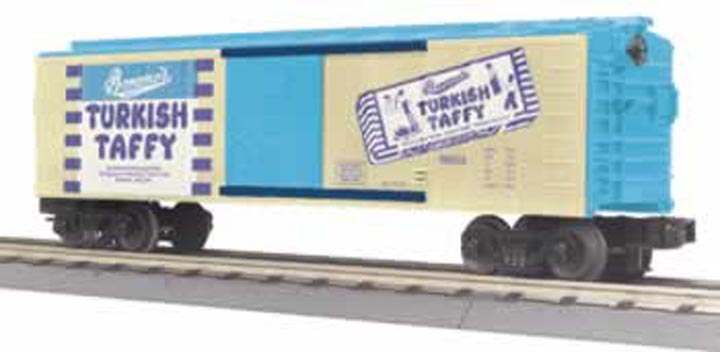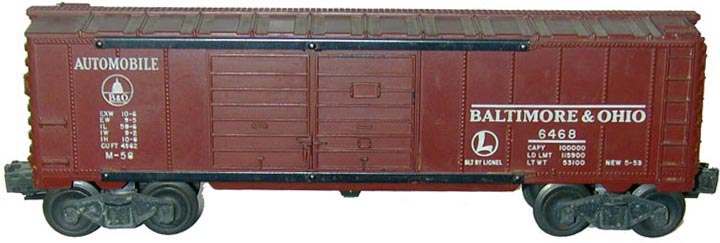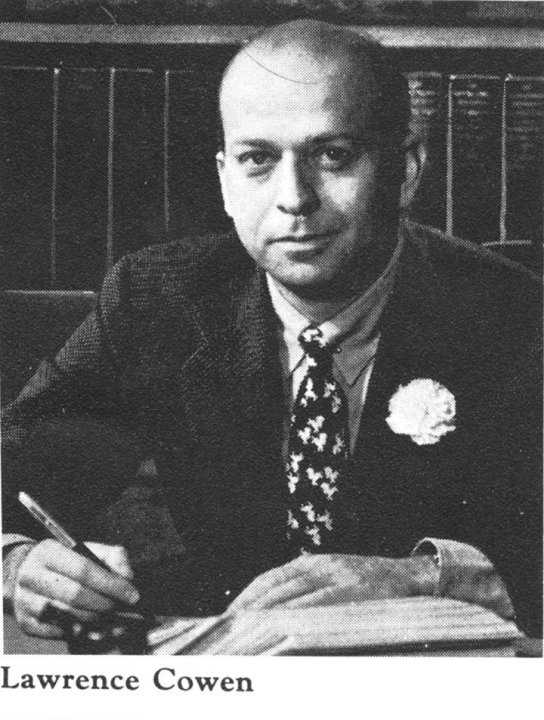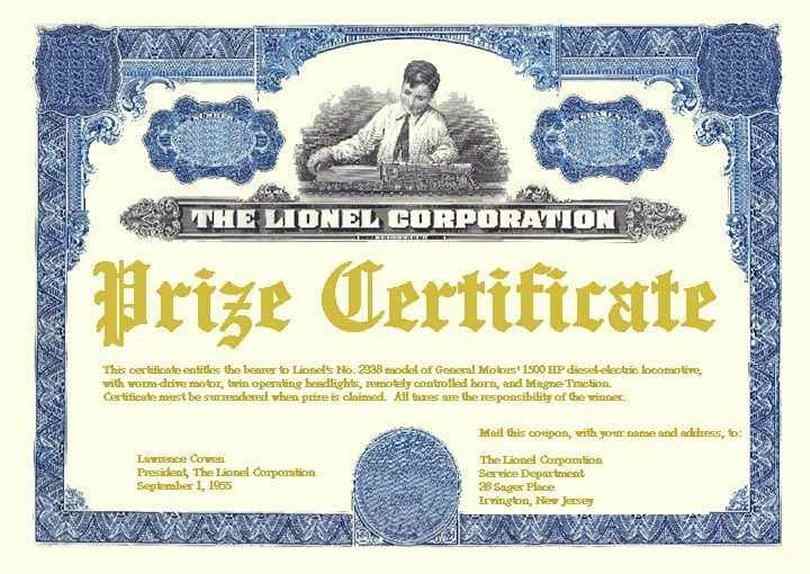I’ve Got a Golden Ticket
By Dr. Joseph Lechner
I never thought my life could be
Anything but catastrophe,
But suddenly I begin to see
A bit of good luck for me.
‘Cause I’ve got a golden ticket,
I’ve got a golden twinkle in my eye;
I never had a chance to shine,
Never a happy song to sing,
But suddenly half the world is mine.
-Anthony Newly
Trucks delivered hundreds of cases of candy to the mansion. Frenzied servants opened chocolate bars by the thousands, discarding the candy and intent only on finding the elusive golden ticket. After days of searching, bratty heiress Veruca Salt got her wish.
Willy Wonka’s elaborate publicity stunt was a success. He hid five golden tickets in unmarked chocolate bars. Candy sales were brisk; and all the tickets were found. Five lucky children got a tour of the Wonka empire, and Charlie Bucket won the factory.
Mike Wolf, founder and CEO of MTH Electric Trains, is betting that the same hidden-ticket ploy will boost sagging sales of his O gauge 3-rail toy trains. He recently announced the first in a series of four boxcars commemorating Bonomo’s Turkish Taffy. Baby boomers fondly remember this rock-hard candy bar that shattered into bite-size pieces when it was smacked against a table. The popular all-day sweet came in vanilla, chocolate, strawberry and banana flavors.
Wolf plans to offer a vanilla taffy car in May 2003, to be followed by chocolate and strawberry. Clever marketing strategy! Sell your customers one item in a series, and they will return time after time to complete the set. But Wolf is only making fifteen of the banana taffy cars, and they’re not for sale. Instead, he plans to conceal tickets inside inconspicuously-unmarked packages of vanilla, chocolate and strawberry; just five tickets in each flavor. If you’re lucky enough to buy a boxcar with a ticket inside, you’ll win a rare, collectible banana car.
That’s Wolf’s theory anyway. He is betting that train collectors will buy taffy cars by the case and rip them open in search of the elusive banana ticket.
Unfortunately, Mike is overlooking a crucial point. Those middle-aged men who buy his stuff are collectors. They prize toy trains so much that they would never play with one for fear of diminishing its value. They all agree that the most desirable train is one that has never been used; a condition that the Train Collectors Association ironically calls mint. But a recent opinion poll conducted by the TCA-sponsored Toy Trains Mailing List affirmed overwhelmingly that a train is only mint if it’s never been removed from its box. Don’t even break the shrink wrap to peek inside; you’ll depreciate its value.
Mike Wolf doesn’t seem to realize that 90% of his purple-and-yellow cartons never even get opened. Some guys will buy a new train and set it on their shelf, still in the box. Their train room looks like the toy floor of a well-stocked urban department store from 1950. Don’t get me wrong; these guys really do enjoy their collections. Just being around all those boxes brings back the joyful anticipation that they felt when they visited the train department at Macy’s when they were five years old.
Other hobbyists will buy trains and then use them as a medium of exchange. Some of them have added a back room to the house and set up rows of shelves to warehouse their merchandise. One collector in Seattle even tunneled underneath his driveway to create a safe hideaway for his cache of trains. These folks will join the TCA just so they can rent a table at its semiannual train shows in York, PA. They’ll buy a sixteen-foot trailer, and an SUV to tow it, so that they can haul all their cargo to and from swap meets. What happens to a train after it’s sold at a TCA meet? Does the happy purchaser take it home and play with it? Naah, he’ll bring it back to York next year and sell it for a dollar more.
Which brings me back to my original point: Mr. Wolf, save your money. Don’t bother with special tooling just to make fifteen banana taffy cars. No one will ever claim them anyway, because no one is going to risk opening a brand-new train package to go looking for your coupon.
I know what I’m talking about. Bigger toy companies than yours have tried and failed. Last year, Lionel LLC tried to stimulate sales by offering $75 rebates on some of its most expensive new engines. But to get the rebate, you had to cut out a proof-of-purchase that was printed on the box. Collectors didn’t send for their rebates! They figured a mint New York Central F-3 would lose more than $75 in equity if the box was cut.
But this wasn’t the first Lionel coupon fiasco. In 1955, the Lionel Toy Corporation was worried about declining sales of its O gauge trains. And with good reason: little boys were becoming more interested in airplanes. Those who still liked model railroads were choosing the smaller HO scale. Lawrence Cowen thought a coupon caper would stimulate sales.
So Lionel employees gathered up some unsold items from the factory and set them aside as prizes. In 1955, they had just introduced models of General Motors’ GP-7 road switcher. The deluxe version, number 2338, was painted orange and black and lettered for the Milwaukee Road. Some of these engines had an orange stripe under the cab window; most had an all-black cab. The real Milwaukee Road engine had orange on the cab; but Lionel customers complained that the interior lighting shone through the plastic shell and made the engine glow in the dark, so dealers returned most of the orange-cab engines to the factory, and their cabs were repainted black. That is, all but the handful that Cowen ordered impounded for his promotion.
Another unsold item that Lionel had too many of in 1955 was number 6468, a model of a double-door automobile boxcar used by the Baltimore and Ohio Railroad. Most 6468s had been painted an attractive sapphire blue, but in 1955 a couple day’s production were painted dull red by mistake. Cowen was sure these red cars would never sell. He packed most of them in a special-order set for a department store, pulled by a Santa Fe F3 diesel, just to get rid of them. But there were still several hundred red 6468s left over.
To encourage sales, Cowen printed special certificates and placed them inside ten randomly-selected red B&O boxcars. The certificate was rolled up and placed inside the car, then all four doors were closed, the car was placed in its orange and blue carton, and the flaps were sealed with tape. The ten certificates were personally signed by Cowen, and they could be redeemed by mailing to Lionel’s service department in Hillside, New Jersey. Each certificate was good for one brand new orange-cab Milwaukee Road GP7. The coupon had no expiration date.
Naturally, Cowen intended to advertise these coupons and their highly-desirable premiums. Unfortunately, due to a marketing-department mixup, this never happened. No coupons were mentioned in Lionel’s 1955 consumer catalog. Nothing appeared in the firm’s ads in Boy’s Life or comic books. Not a word was said in Lionel’s annual letter to its network of dealers. The certificates left the factory in a big shipment destined for Chicago, and no one ever saw them again.
Service manager Lenny Dean placed those ten 2338s in a vault at the Lionel factory in December 1955. Fourteen years later, he was there to help close the factory, and all the diesels were still unclaimed.
Lenny Dean is an honorable businessman. He is highly respected by toy train collectors, and when he appears at a Toy Fair or a York, hundreds of fans will line up to shake his hand or to get his autograph. Lenny Dean views a coupon as a binding contract. Somewhere out there, somebody has those certificates and is entitled to claim their premiums. So, when Lionel’s assets were sold to General Mills in 1970, Dean saw to it that the orange 2338s got moved to Mount Clemens, Michigan. They were still there in 1986 when Richard Kughn took over the company. They are still there today. Lionel LLC’s Bill Bracy has pledged himself to honor the offer that his predecessor Lawrence Cowen made almost fifty years ago. The Milwaukee Geeps were still safely locked away when Lionel’s tooling was moved to China and most of the leftover inventory was auctioned off in 2002.
They are still waiting for somebody to bring in the coupons and claim them.
The terms of this offer are very simple. You simply find the certificate rolled up inside a red 6468 B&O boxcar, take it to Lionel headquarters, and ask for your orange Geep.
Why haven’t any of these coupons been discovered? A 6468 has double doors that slide wide open. This car was specifically designed to hold those miniature Ford Fairlanes that came with Lionel’s 6414 Auto-Loader and 6424 flat car. The certificates are 9” long, so even when they’re rolled up, they completely fill the interior of the boxcar. Slide open the doors, and if there’s a coupon inside, you’ll find it right away. You can’t miss it. But since 1955, not one of these certificates has ever turned up inside any of the thousands of 6468s that have been opened and played with. This can only mean one thing: there are ten factory sealed, mint-in-box tuscan 6468s still out there somewhere, each with Lawrence Cowen’s autograph inside them. Do you have one? What are you waiting for? Break the seal, open the carton, and look inside that boxcar. You may already be a winner!
P.S. The coupons are printed on parchment with imitation gold ink, similar to stock certificates issued by Lionel Toy Corporation throughout the 1950s. Since the ink is non-metallic, you cannot detect the coupon by X raying a sealed carton. You’ve got to open the box! To win, you’ve got to enter!











